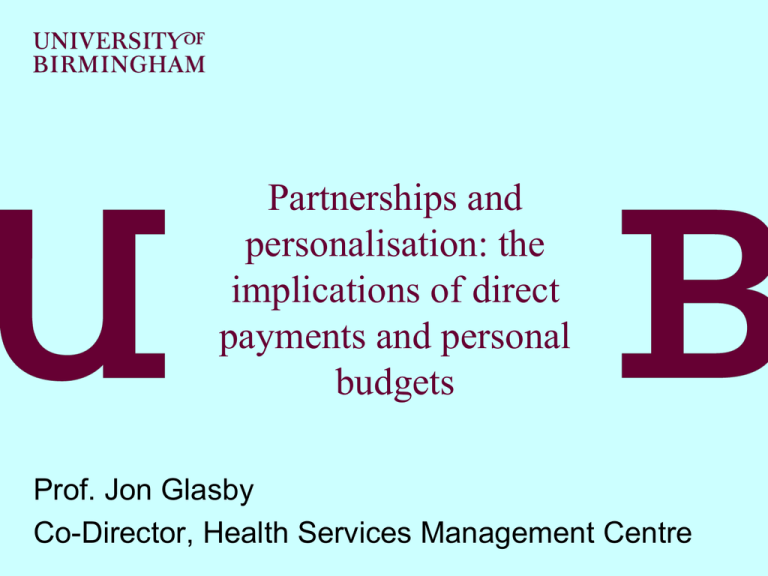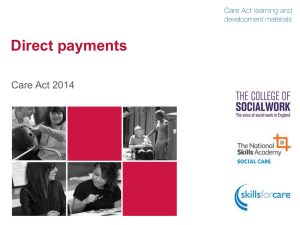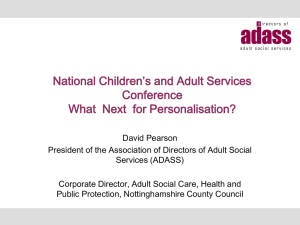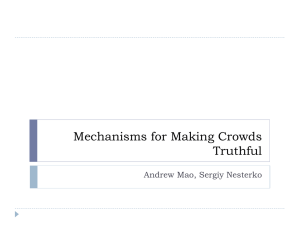Individual budgets and healthcare presentation by Jon
advertisement

Partnerships and personalisation: the implications of direct payments and personal budgets Prof. Jon Glasby Co-Director, Health Services Management Centre Outline Background Advantages/barriers Personal budgets Implications for social care (Tentative) implications for health care 1. Background “The potential for the most fundamental reorganisation of welfare for half a century” Cash payments to service users aged 18-65 in lieu of direct service provision Extended to include older people, younger people aged 16 and 17, carers and the parents of disabled children Now mandatory rather than discretionary 1. Background Illegal under 1948 legislation Indirect payments (pioneered by disabled people) ILF 1990 NHS and Community Care Act Lobbying and research by disabled people Disabled people involved in implementing direct payments 1. Direct Payments are very simple – it’s not hard Direct Payments = a means to an end (of independent living) Choice and control are central 2. Advantages More responsive services and increased choice and control Improved morale and mental/psychological wellbeing A more creative use of resources which may sometimes reduce costs, but which certainly ensures better value for money A blurring of the boundary between health and social care 2. Barriers Perceived focus on physical impairment ‘Willing and able’ Complexity of monitoring arrangements Staff attitudes and knowledge Political concerns in some authorities: ‘privatisation by the backdoor’? Boundaries with NHS and housing 3. Personal budgets Rights-based approach (more like social security than traditional social care) Links to PCP and circles of support Sees DPs/PBs as a means to an end Can use same resources much more effectively Emphasised in the White Paper and being rolled out 3. Seven steps to Self-directed Support Set PB (using in Control’s RAS) Plan support – with support as needed Agree plan Manage PB (currently 6 distinct degrees of control) Organise support – complete flexibility Live life - people use their PBs to achieve outcomes important to them Review and learn 4. Implications for social care “In the future, all individuals eligible for publiclyfunded adult social care will have a personal budget (other than in circumstances where people require emergency access to provision): a clear, upfront allocation of funding to enable them to make informed choices about how best to meet their needs.” (Transforming social care 2008 circular) 4. Implications for social care Not a matter of ‘whether’ but of ‘how’ and ‘how quickly’ Significant cultural challenges for whole of social care Key test will be not regulating/scrutinising the new system to death Focus shifts from assessment and from services to planning/review/outcomes Holds out the potential for reforming the system as a whole – not just bolting on to the existing system 5. (Tentative) implications for health People do use DP/PB for health care Separating health and social care rarely makes sense to the individual (or workers) DP/PB for social care and not health flies in the face of the partnership agenda DP/PB could help the NHS deliver key priorities Growing sense of momentum 5. What could the world be like? – HSMC’s expert seminar, 2004 How can we make direct payments work better in integrated health and social care settings? Could/should direct payments be extended to health care and in which areas of health care? What implications might this have? Could we learn from the choice and control of direct payments to improve health care? 5. What could the world be like? – HSMC’s expert seminar, 2004 Would fit well with long-term conditions agenda Scope to extend to specific groups Wide concerns about a broader roll out (equity, supply, cost etc) Scope to learn DP lessons in health care Need to repeat the 1990s battle for ‘hearts and minds’ 5. Key questions for health care? When might it improve outcomes if people know upfront how much is available to meet their needs? When could the person/those close to them/a worker achieve better outcomes by having the flexibility to be creative? Where is it really important that support is truly personalised? 5. Possible areas for an integrated PB? LTC (admission avoidance)? Mental health (recovery budget)? Continuing care? Maternity services? Expensive out-of-area placements? Learning difficulty services? Disabled children? End of life care? Etc etc 5. How could this work for LTCs? Scope for an admission avoidance scheme (with IB set at a % of the tariff)? Scope to compare community matron v budget-holding professional v CIL/peer support model? Scope to work with LA to make money available (similar to Pointon case)? Scope to encourage Independent Living Trusts? Further information Alakeson, V. (2008) Let patients control the purse strings, BMJ, 12 April, 807-809 Glasby, J. and Duffy, S. (2007) – policy paper on direct payments and health (www.bham.ac.uk/hsmc) Glasby and Littlechild (2009) Direct payments and personal budgets. Policy Press In Control (www.in-control.org.uk) National Centre for Independent Living (www.ncil.org.uk) See also, the partnerships and personalisation section of the HSMC website











